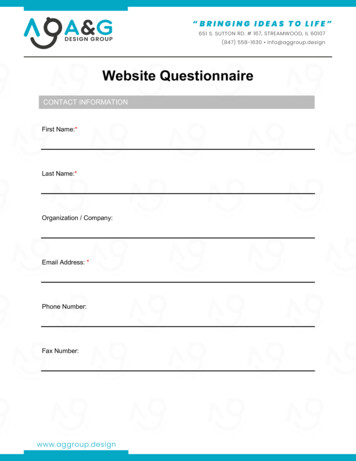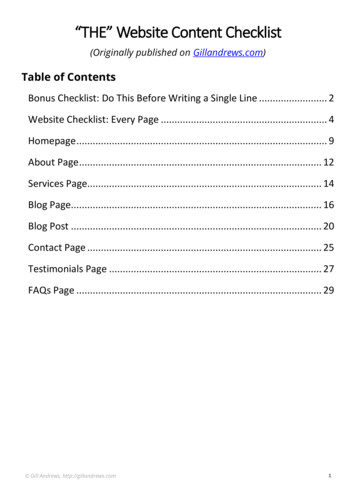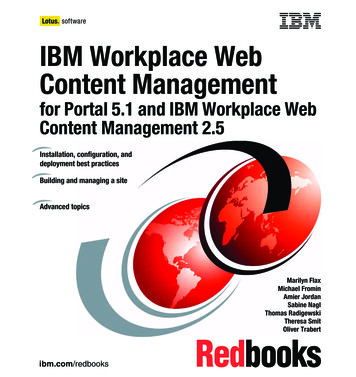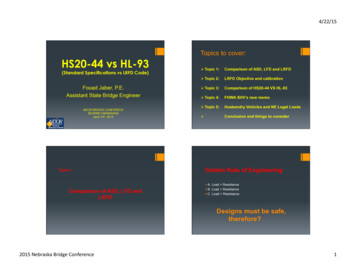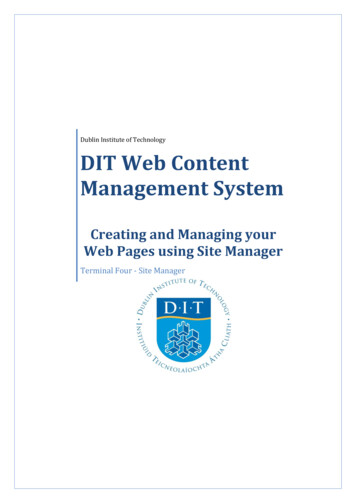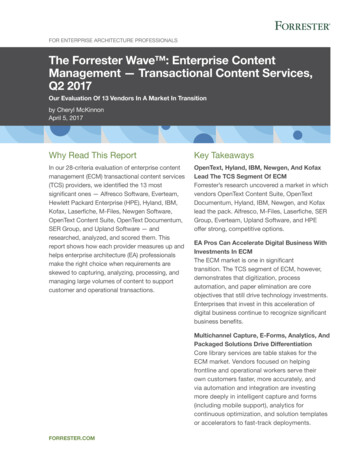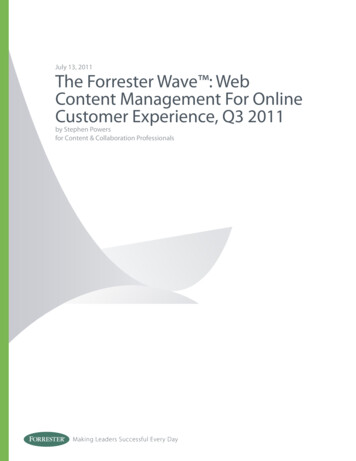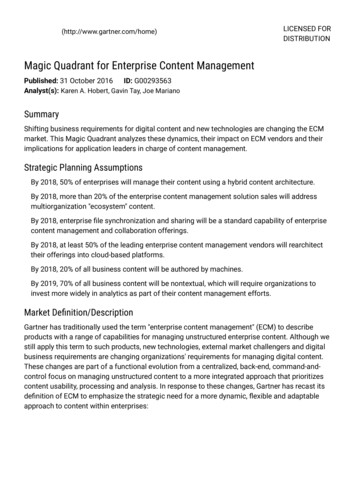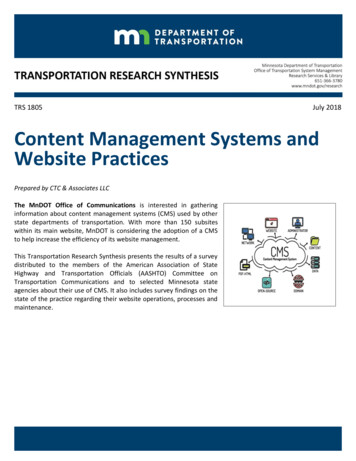
Transcription
TRS 1805July 2018Content Management Systems andWebsite PracticesPrepared by CTC & Associates LLCThe MnDOT Office of Communications is interested in gatheringinformation about content management systems (CMS) used by otherstate departments of transportation. With more than 150 subsiteswithin its main website, MnDOT is considering the adoption of a CMSto help increase the efficiency of its website management.This Transportation Research Synthesis presents the results of a surveydistributed to the members of the American Association of StateHighway and Transportation Officials (AASHTO) Committee onTransportation Communications and to selected Minnesota stateagencies about their use of CMS. It also includes survey findings on thestate of the practice regarding their website operations, processes andmaintenance.
Technical Advisory PanelMicheal Foley, Technical LiaisonMnDOT Office of CommunicationsMaina Tran, Principal InvestigatorCTC & Associates LLCMark Linsenmayer, Principal InvestigatorCTC & Associates LLCDan Warzala, Project CoordinatorMnDOT Research Services & LibraryAdam Oie, PanelistMnDOT Office of CommunicationsGregory Ruhland, PanelistMnDOT Office of CommunicationsThe purpose of this Transportation Research Synthesis (TRS) is to serve as a synthesis of pertinent completedresearch to be used for further study and evaluation by MnDOT. This TRS does not represent the conclusions ofeither the authors or MnDOT.
Content Management Systems and Website PracticesIntroductionMnDOT’s Office of Communications is considering the adoption of a content management system (CMS) tomanage the agency’s main website and more than 150 subsites. To inform its selection of a CMS, MnDOT isseeking information from other state departments of transportation (DOTs) and Minnesota state agencies abouttheir use of CMS. MnDOT is also interested in information about web operation practices to help streamlineinternal web content management and website practices. This Transportation Research Synthesis presents thefindings of a survey sent to all 50 state DOTs and selected Minnesota state agencies.Summary of FindingsSurvey of PracticeAn online survey was distributed to members of the AASHTO Committee on Transportation Communicationsand selected Minnesota state agencies about the use of CMS and website operation practices. Twenty-one stateDOTs and seven Minnesota state agencies responded to the survey. Below are highlights of the survey results inthe following topic areas: Types of CMS and other technology. CMS costs and funding. Processes and workflows of website operations. Governance of CMS.Types of Content Management Systems and Other TechnologyMost agencies use either SharePoint or Drupal as a CMS. Five respondents do not use a CMS and the remainingrespondents cited 14 other systems. Almost half the agencies noted that their current system is also their firstwith more than half using their system for more than five years.One-half of the agencies used both an in-house IT team and an outside consultant to install their CMS. Trainingand customization issues were cited as the top reasons for installation issues.CMS Costs and FundingMost respondents did not provide information on costs and fees associated with their CMS. Three agenciesreported upfront costs in the range of 28,000 to 30,000. Washington State DOT spent approximately 50,000and Iowa DOT spent 200,000 in consulting fees for migration and training. Of the states providing feeinformation, licensing, server, hosting and user fees range from 24,000 to 50,000 per year. Arizona DOTspends approximately 5,000 per year for the Sitefinity CMS, not including support and maintenance costs,which were not provided.Processes and Workflows of Website OperationsThere was little consensus among respondents about the process used for updating content or creating newweb pages, although some common practices were identified:Prepared by CTC & Associates1
Content updates are usually executed by a web content person from each department or division. Website changes need approval before they are published. Requests for website changes are made by completing a web request form or by sending an email tothe appropriate web person.When respondents were asked to rate the ease of use on tasks such as updating web page content, makingchanges to web page design and making web administrative changes to the CMS system, most respondents didnot report difficulties when updating web content regardless of the CMS used. Drupal was consistently rated aseasier to use than SharePoint with regard to the other two tasks.Governance of CMSIn most cases, the agency’s information technology (IT) department oversees the web infrastructure. Fiveagencies reported that their communications department is responsible. Most IT teams have two to four peoplewho support a larger group of web users and can make content updates. The number of staff with full webadministrative rights is restricted to a small group of people. Even though a large number of staff at mostagencies can update website content, 18 respondents reported that their website content is centralized.Management of the general website is usually the responsibility of the IT department, however, some agenciesassign responsibility to the communications department or the public information office.Next StepsMoving forward, MnDOT may wish to consider: Re-examining MnDOT’s website requirements to determine if Drupal or SharePoint would be viableoptions as a CMS. Following up with states for further information on CMS installation issues to avoid duplicating the samemistakes. This will aid in saving time and installation costs. Contacting the Minnesota Department of Employment and Economic Development about its experiencewith SDL Tridion and to obtain additional cost information.Prepared by CTC & Associates2
Detailed FindingsSurvey of PracticeAn online survey was distributed to two groups: members of the AASHTO Committee on TransportationCommunications, which includes representatives from all state departments of transportation (DOTs), andmembers of selected Minnesota state agencies. Representatives from both groups were surveyed on their useof content management systems (CMS) and website operation practices.Twenty-one states responded to the survey: Alaska. Louisiana. North Dakota. Arizona. Michigan. Pennsylvania. Arkansas. Mississippi. Utah. Indiana. Montana. Vermont. Iowa. Nevada. Virginia. Kansas. New Hampshire. Washington. Kentucky. North Carolina. Wyoming.Seven Minnesota state agencies responded to the survey: Department of Agriculture (MDA). Department of Employment and Economic Development (DEED). Department of Labor and Industry (DLI). Department of Natural Resources (DNR). Department of Public Safety (DPS). Metropolitan Council. Minnesota Pollution Control Agency (MPCA).Appendix A provides the full text of the survey questions. The full text of survey responses is presented in asupplement to this report. Appendix B provides the contact information for all survey respondents.Below is a discussion of survey results in six topic areas: Information technology (IT) staff and website permissions. Types of CMS and third-party systems. CMS costs and funding. Processes and workflow of website operations and maintenance. Governance of website operations and management. Other website technology tools.Prepared by CTC & Associates3
Supplementing these survey results are findings from a limited literature search, which are provided in RelatedResources sections throughout the report.Information Technology Staff and Website PermissionsRespondents were asked to report the total number of staff on their IT website team and indicate the number ofstaff with the following level of web permissions: make content changes to web pages, make web page designchanges and have full administrative web access rights. The number of staff members on an agency’s IT teamranged from one to 17, with a majority staffing two to four people. The Washington State DOT respondentreported that the agency currently has one content editor, one mobile developer, two technical support staffmembers managing help calls and one Drupal administrator. He added that the agency needed three contenteditors at a minimum and two Drupal administrators.The number of staff who can make web content changes is much larger than the number of staff with fulladministrative website rights. For most agencies, the number of staff with permission to make web page designchanges is similar to the number of staff with administrative rights.The only exception is in Vermont, where all staff who work on the website, including the four IT staff members,have full administrative rights. In a follow-up communication with the Vermont Agency of Transportation (whichuses Drupal as its CMS), the respondent stated that the basic editing permissions did not meet the needs of theweb users. Because Drupal did not have the permission settings needed, the agency gave all web users fulladministrative rights with the understanding that users only work within their own department web pages.The table below summarizes survey responses.IT Staff and Website PermissionsTotal IT StaffMake ContentChangesMake Web PageDesign na535856State /AgencyPrepared by CTC & Associates4
IT Staff and Website PermissionsTotal IT StaffMake ContentChangesMake Web PageDesign n a3333MPCA8582Nevada112033New Hampshire3-4653-43-4North Carolina133103-4North Dakota3 (part te /Agency*Two staff plus a student.Prepared by CTC & Associates5
Types of Content Management Systems and Third-Party SystemsCurrent Content Management SystemThe types of CMS used by respondents varied widely. SharePoint and Drupal are the two most commonly usedsystems (see bar graph and table below). Seven survey respondents reported using SharePoint (DEED, DPS,Kentucky, Louisiana, Mississippi, North Carolina and Pennsylvania); five respondents reported using Drupal(DNR, MPCA, Vermont and Washington; DLI will launch in June 2018).Drupal5SharePoint7Other14No CMS50246810121416Number of State DOTs and AgenciesFigure 1. Types of CMSOther CMS used by survey respondents are listed below: Crownpeak. RedDot (now OpenText Web Site Management). DNN Evoq. SDL Tridion. Jahia Digital Experience Platform. Sitecore. Kentico .NET Web Content Management. Sitefinity. Microsoft Content Management Server(MCMS) 2002. Vignette (now OpenText Web ExperienceManagement). Oracle Application Express (APEX)(proprietary system). visionLive. WordPress.Percussion CM1.Some agencies use more than one CMS. DEED uses SharePoint for the agency’s intranet and SDL Tridion for itspublic website. In addition to using Drupal, Washington State DOT uses MCMS 2002 and DNR uses WordPress.Five agencies—Alaska, Arkansas, Montana, New Hampshire and North Dakota—do not use a CMS. Both theArkansas and New Hampshire DOT respondents reported using Dreamweaver (part of the Adobe Creative Suite).Prepared by CTC & Associates6
North Dakota DOT uses custom .NET applications to mimic CMS elements. Montana DOT is currently conductinga web assessment of its internet site and is expected to receive recommendations about a CMS as a result of theassessment.Brief summaries and links to more information about CMS used by survey participants are provided in RelatedResources at the end of this report.Summary of Content Management Systems Used by niaDNN EvoqIowaDrupalDLI, MPCA and VermontDrupal, MCMS 2002WashingtonDrupal, WordPressDNRJahia Digital Experience PlatformWyomingKentico .NET Web ContentManagementMetropolitan CouncilOracle Application Express (APEX)(proprietary system)UtahPercussion CM1KansasRedDot (now OpenText Web SiteManagement)IndianaSharePointDPS, Kentucky, Louisiana,Mississippi, North Carolinaand PennsylvaniaSharePoint, SDL TridionDEEDSitecoreMDASitefinityArizonaVignette (now OpenText WebExperience Management)MichiganvisionLiveNevadaPrepared by CTC & Associates7
Content Management System Usage TimeOf the 23 agencies using a CMS, more than half have used their system for more than five years. One-third ofthe agencies have used their CMS for two to four years. Wyoming DOT has used Jahia CMS for over 10 years.The DLI respondent noted that the agency plans to launch its new Drupal site in June 2018.Less than 1 year9%22-4 years835%5 years or more1252%Other4% 102468101214Number of RespondentsFigure 2. Length of CMS UsePrevious Content Management SystemTen agencies—Arizona, DLI, DPS, Iowa, Kansas, Kentucky, MDA, Metropolitan Council, Michigan and Utah—saidtheir current CMS is their agency’s first system. SharePoint was the previous CMS in three states (Indiana,Mississippi and Washington). Three other respondents (DNR, Virginia and Wyoming) developed their CMS inhouse. Other systems used by agencies are listed below: ASP.NET (Louisiana). Drupal 6 (Vermont). Crownpeak (DEED). Ektron CMS (Nevada). Domino (Pennsylvania). Joomla (MPCA).Third-Party SystemsRespondents were asked about database systems used before and after installation of the CMS. Ninerespondents reported using one of the following systems: ColdFusion (MPCA). Domino (Pennsylvania). FrontPage (Vermont). Oracle (Michigan and Wyoming). Proprietary system (Washington). SQL/MySQL (DNR, Louisiana and Mississippi).Prepared by CTC & Associates8
Apart from Washington State DOT (which created a proprietary system) and Arizona DOT (SQL), the remainingagencies continued using the same database with the new CMS system.Five respondents reported using the following new database: Crownpeak (Virginia). Oracle (Utah). SharePoint (Pennsylvania, which still uses Domino, but converts to SharePoint when possible). SQL (Arizona and DPS)Only four respondents cited a third-party system that is integrated with their current CMS: GovDelivery, Web 2.0 email and SMS messaging platform (MPCA). Nintex Workflow process automation tool (Mississippi). Trumba calendar tool (DEED). Webtrends and Siteimprove website analytics tools (Virginia).Content Management System Installation and IssuesWhile half of the respondents used both an in-house IT team and outside consultants to assist with installationof a new CMS system, about one-third of respondents with a CMS used their own staff for the installation. Outside consultant: Arizona and DLI. In-house IT team: DNR, Indiana, Kentucky, Louisiana, Nevada, Vermont, Virginia (Communications webteam) and Wyoming. Both: DPS, Iowa, Kansas, MDA, Metropolitan Council, Michigan, Mississippi, MPCA, North Carolina,Pennsylvania, Utah and Washington. Other: DEED (DEED web team and Minnesota IT Services (MNIT)).4%9%Outside ConsultantIn-house IT Team35%52%BothOtherFigure 3. CMS Installation AssistancePrepared by CTC & Associates9
Some of the respondents indicated issues with the installation, primarily related to customization, systemmigration and user training. In Arizona, the respondent encouraged agencies considering new systems toevaluate their needs realistically and to be selective and open to new practices. The agency gave responsibilityfor setup and customization of its Sitefinity platform to a consultant team (with final content review andpublication handled internally) primarily because of the level of knowledge required to set up and customize a.NET platform. While the agency has learned more about this system over the years, the web team is still heavilyreliant on developers to make substantive and functional changes when needed. At the time of the conversion,Arizona tried in several ways to make the tool meet current needs and practices, but over time many of thosepractices became outdated and now, some of the changes that were considered necessary are ignored.The table below summarizes survey responses.CMS Installation tions for practices that later becameoutdated.MPCACustomizations that are not sustainable withlarge CMS changes.CustomizationDomain changeNevadaFamiliarity with new systemDLIHostingDNRStaff involvementWashingtonStaff unwilling to clean content before migrationto new system.System migrationVirginiaDouble update everything in first transition (codefreeze not possible). First redesign much easier.System requirementsArizonaTrainingLearning the pros and cons of Drupal 8. Initial load balancing. URL migration from http to https.LouisianaTraining users and educating the public,businesses and contractors.NevadaPoor user training. Analytics tracking.OtherPrepared by CTC & AssociatesNevada Updating URLs in printed and electronicmaterials.10
Ease of UseUsing a rating scale ranging from very easy to very difficult, respondents rated the ease of use when performingthree tasks on the agency’s current CMS: Updating web page content. Making changes to web page design and layout. Making web administrative changes to the CMS.Regardless of the CMS used, most respondents did not report difficulties when updating web page content. Onerespondent (MDA) rated Sitecore as somewhat difficult to use when performing this task.Respondents reported a wider range of ratings for making web page design changes. Drupal received more veryto somewhat easy ratings than SharePoint, where ratings ranged from very easy to very difficult.Results were similar regarding the task of making web administrative changes to the CMS. Again, Drupalreceived more favorable ratings than SharePoint.The Arizona DOT respondent noted that content updates to Sitefinity are easy, as are building pages, deletingpages and generally maintaining content. Some changes to page templates and local CSS (Cascading StyleSheets) are easy while other changes that require code access and changes are much more difficult and requiretechnical support.Ratings from survey respondents are summarized in the following tables.Prepared by CTC & Associates11
Respondents’ Assessment of Updating Web Page ContentPerformanceAssessmentVery easySomewhateasySomewhatdifficultPrepared by CTC & rmontDrupal, MCMS 2002WashingtonJahiaWyomingPercussion CM1KansasRedDotIndianaSharePointKentucky, LouisianaSitefinityArizonaDNN EvoqIowaDrupalDLI, MPCAOracle APEX (proprietary system)UtahSharePointDPS, Mississippi,North Carolina,PennsylvaniaSharePoint, SDL eMDA12
Respondents’ Assessment of Changing Web Page DesignPerformanceAssessmentVery easySomewhateasySomewhatdifficultVery difficultPrepared by CTC & olitan CouncilSharePointLouisianaDrupalDLI, VermontDrupal, MCMS 2002WashingtonDrupal, WordPressDNROracle APEX (proprietary system)UtahPercussion CM1KansasRedDotIndianaSharePointDPS, North Carolina,PennsylvaniaCrownpeakVirginiaDNN EvoqIowaDrupalMPCASharePointKentuckySharePoint, SDL ointMississippiSitecoreMDAvisionLiveNevada13
Respondents’ Assessment of Making Website Administrative ChangesPerformanceAssessmentVery easySomewhateasySomewhatdifficultVery montDNN EvoqIowaDrupalDLIDrupal, MCMS 2002WashingtonDrupal, WordPressDNRJahiaWyomingKenticoMetropolitan CouncilOracle APEX (proprietary system)UtahRedDotIndianaSharePointNorth CarolinaSitecoreMDAPercussion CM1KansasSharePointDPS, Kentucky,Louisiana,PennsylvaniaSharePoint, SDL ignetteMichiganvisionLiveNevadaFuture PlansSeveral respondents provided details about future plans for the agency CMS: The respondent from Arizona DOT, which uses Sitefini
Kenti co .NET Web Content Management . Microsoft Content Management Server (MCMS) 2002 . Oracle Applica tion Express ( APEX ) (proprietary system) . Percussion CM1 . RedDot (now OpenText Web Site Management) . SDL Tridion . Sitecore. Sitefinity . Vignette (no
